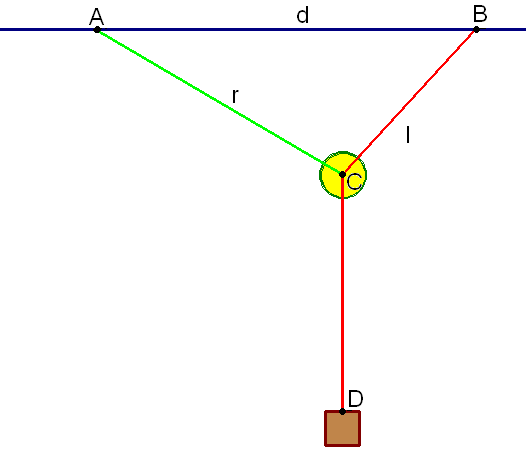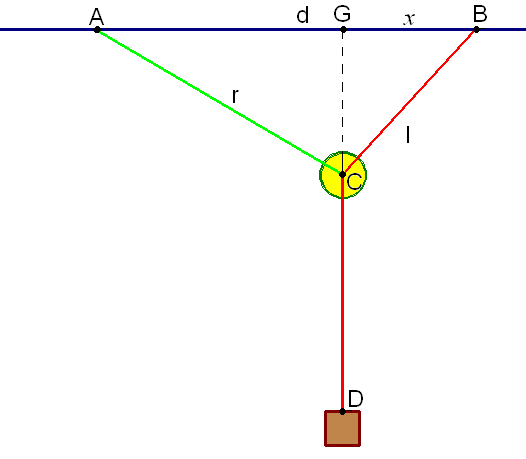- About MAA
- Membership
- MAA Publications
- Periodicals
- Blogs
- MAA Book Series
- MAA Press (an imprint of the AMS)
- MAA Notes
- MAA Reviews
- Mathematical Communication
- Information for Libraries
- Author Resources
- Advertise with MAA
- Meetings
- Competitions
- Programs
- Communities
- MAA Sections
- SIGMAA
- MAA Connect
- Students
- MAA Awards
- Awards Booklets
- Writing Awards
- Teaching Awards
- Service Awards
- Research Awards
- Lecture Awards
- Putnam Competition Individual and Team Winners
- D. E. Shaw Group AMC 8 Awards & Certificates
- Maryam Mirzakhani AMC 10 A Awards & Certificates
- Two Sigma AMC 10 B Awards & Certificates
- Jane Street AMC 12 A Awards & Certificates
- Akamai AMC 12 B Awards & Certificates
- High School Teachers
- News
You are here
Historical Activities for Calculus - Module 3: Optimization – L'Hôpital's Pulley Problem
L'Hôpital's Pulley Problem and the Principle of Least Potential Energy
The first calculus textbook was written by the Marquis Guillaume-Francois-Antoine de l'Hôpital (1661-1704). Best known for the famous rule that bears his name that is used to compute limits of indeterminate forms, l'Hôpital was very interested in mathematics and particularly in the new techniques of the calculus that had recently been developed by Isaac Newton (1643-1727) and Gottfried Wilhelm Leibniz (1646-1716). Consequently, he hired one of Leibniz's best students, Johann Bernoulli (1667-1748), to teach the calculus to him. L'Hôpital then took the notes he compiled from Bernoulli's lectures and organized them into a textbook called Analyse des Infiniment Petits. The book contained the original results of Newton, Leibniz, and Johann Bernoulli, as well as Johann's brother Jakob Bernoulli (1654-1705). L'Hôpital has been justly criticized for giving little or no credit to these mathematicians, presenting the mathematics as if it were his own. Indeed, many have suggested that l'Hôpital 's Rule should really be called Bernoulli's Rule, since it was taught to him by Johann! Johann Bernoulli was forced to keep silent during l'Hôpital 's lifetime since l'Hôpital had essentially paid him for the right to use Bernoulli's results in any way he wanted. After l'Hôpital's death, however, Bernoulli began to take credit for practically the entire book.
Being a textbook, Analyse des Infiniment Petits contains a number of interesting problems that are used to demonstrate the techniques of the new calculus. One of these problems is the famous Pulley Problem, illustrated below.

Figure 37. L'Hôpital's Pulley Problem
A (weightless) cable of length \(r\) is attached to the ceiling at point \(A.\) The other end of the cable is attached to a pulley at point \(C\). The end of another cable of length \(l\) is attached to the ceiling at point \(B,\) where \(|AB|=d\) and \(d>r\). At the other end of the second cable (point \(D\)) is attached a weight. This second cable passes over the pulley, so \(|BC|+|CD|=l,\) and the whole system is allowed to adjust itself to reach a state of stationary equilibrium. The question is: How far below the ceiling is the final position of the weight? The solution relies on the principle of minimum potential energy. This means that the system will be stable when its potential energy is the least; that is, when the weight hangs as far below the ceiling as possible. Use the applet in Figure 38, below, to explore l'Hôpital's Pulley Problem and identify the approximate equilibrium position for the example shown.
Figure 38. Use this applet to explore l'Hôpital's Pulley Problem.
Exercises
Figure 39. L'Hôpital's Pulley Problem for Exercise 10
Exercise 10.
In Figure 39, above, \(|AB|=d,\) \(|AC|=r,\) and \(|BC|+|CD|=l.\) Let \(x\) be the horizontal distance between \(G\) and \(B.\)
(a) Find an expression for \(|GA|.\)
(b) Find an expression for \(|GC|.\)
(c) Find an expression for \(|BC|.\)
(d) Find an expression for \(|CD|.\)
(e) Find an expression for \(|GD|.\)
(f) According to the principle of minimum potential energy, the system will reach equilibrium when \(|GD|\) is maximized. Use calculus and a CAS to find the value of \(x\) for which \(|GD|\) is a maximum.
(g) Compute \(x\) when \(d=12,\) \(r=7,\) and \(l=14.\)
Figure 38 (repeated from above). Use this applet for Exercise 10, part h.
(h) The applet in Figure 38 illustrates the Pulley Problem. Drag \(C\) to locate the equilibrium position where \(|GD|\) is a maximum. Does \(x=|GB|\) agree with your solution above?
Gabriela R. Sanchis (Elizabethtown College), "Historical Activities for Calculus - Module 3: Optimization – L'Hôpital's Pulley Problem," Convergence (July 2014)





